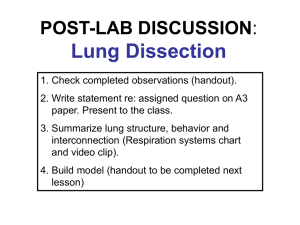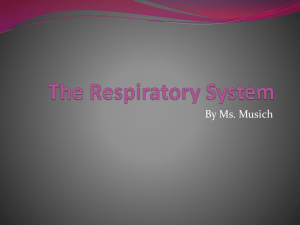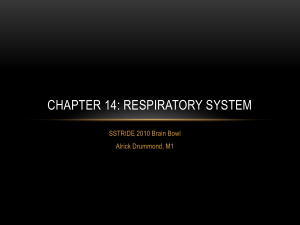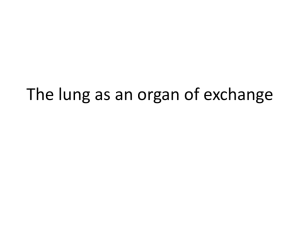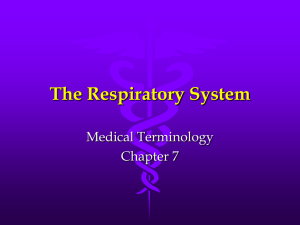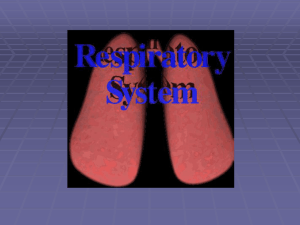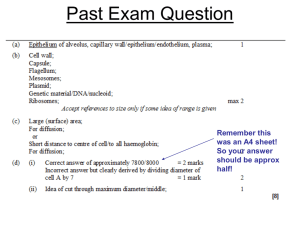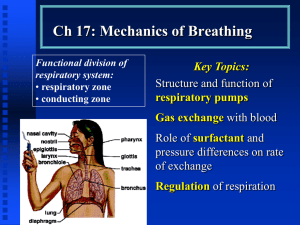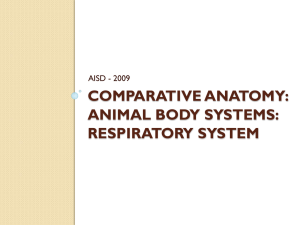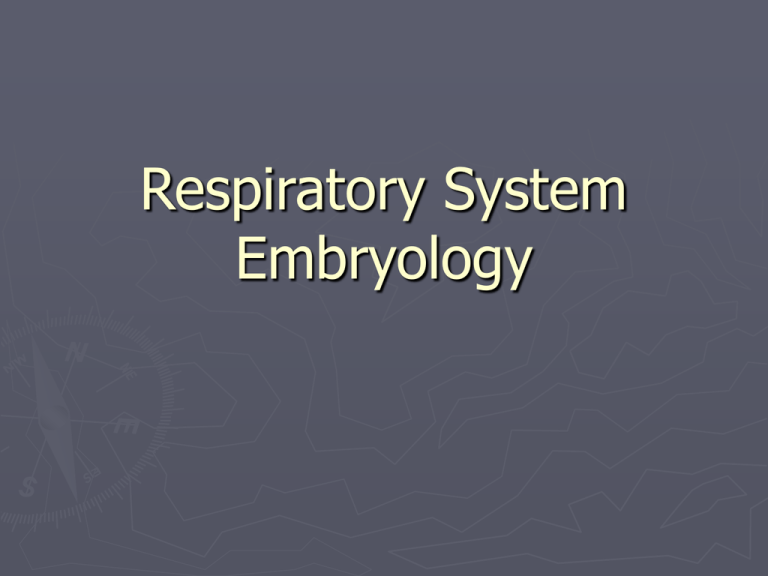
Respiratory System
Embryology
Development of the
nose and Palate
Development of the nose
►
At the end of the fourth week,
facial prominences consisting
primarily of neural crest-derived
mesenchyme and formed mainly by
the first pair of pharyngeal arches
appear
►
The frontonasal prominence,
formed by proliferation of
mesenchyme ventral to the brain
vesicles, constitutes the upper
border of the stomodeum
►
On both sides of the frontonasal
prominence, local thickenings of the
surface ectoderm, the nasal
(olfactory) placodes, originate
under inductive influence of the
ventral portion of the forebrain
Development of the nose
►
During the fifth week, the nasal
placodes invaginate to form
nasal pits (nostril) .
►
In so doing, they create a ridge
of tissue that surrounds each pit
and forms the nasal
prominences.
►
The prominences on the outer
edge of the pits are the lateral
nasal prominences; those on
the inner edge are the medial
nasal prominences
Development of the nose
►
During the following 2 weeks,
the maxillary prominences
continue to increase in size
►
Simultaneously, they grow
medially, compressing the
medial nasal prominences
toward the midline
►
Subsequently the cleft between
the medial nasal prominence
and the maxillary prominence is
lost, and the two fuse
Development of the nose
►
The nose is formed from five facial
prominences
►
the frontal prominence gives rise to
the bridge; and nasal septum
►
the merged medial nasal
prominences provide the crest and
tip;
►
the lateral nasal prominences form
the sides (alae)
►
Olfactory pit forms the nostril and
then becomes deeper to form a
blind sac ( the vestibule)
Development of the nose
Nasal Cavities
► 1.
During the sixth
week, the nasal pits
deepen considerably,
partly because of
growth of the
surrounding nasal
prominences and
partly because of their
penetration into the
underlying
mesenchyme
Nasal Cavities
►
2. At first the oronasal
membrane (floor of the
nose) separates the pits
from the primitive oral
cavity by way of the newly
formed foramina, the
primitive choanae
►
These choanae lie on each
side of the midline and
immediately behind the
primary palate.
Nasal Cavities
►
3. Later, with formation of
the secondary palate and
further development of the
primitive nasal chambers
►
the definitive choanae
will lie at the junction of
the nasal cavity and the
pharynx (nasopharynx).
Paranasal air sinuses
► Paranasal
air sinuses develop as
diverticula of the lateral nasal wall and
extend into the maxilla, ethmoid, frontal,
and sphenoid bones.
► They
reach their maximum size during
puberty and contribute to the definitive
shape of the face.
Primary palate
►
As a result of medial growth of the maxillary
prominences, the two medial nasal
prominences merge not only at the surface
but also at a deeper level.
►
The structure formed by the two merged
prominences is the intermaxillary
segment
►
It is composed of (a) a labial component,
which forms the philtrum of the upper lip;
►
(b) an upper jaw component, which
carries the four incisor teeth;
►
(c) a palatal component, which forms the
triangular primary palate
►
The intermaxillary segment is continuous
with the rostral portion of the nasal
septum, which is formed by the frontal
prominence.
Secondary Palate
►
the main part of the
definitive palate is formed
by two shelflike
outgrowths from the
maxillary prominences.
►
These outgrowths, the
palatine shelves, appear
in the sixth week of
development and are
directed obliquely
downward on each side of
the tongue
Secondary Palate
► In
the seventh week,
however, the palatine
shelves ascend to
attain a horizontal
position above the
tongue and fuse,
forming the
secondary palate
Secondary Palate
►
Anteriorly, the shelves fuse
with the triangular primary
palate, and the incisive
foramen is the midline
landmark between the
primary and secondary
palates
►
At the same time as the
palatine shelves fuse, the
nasal septum grows down
and joins with the cephalic
aspect of the newly
formed palate
Secondary Palate
►2
folds grow posteriorly from the edge of the
palatine process to form the soft palate and the
uvula.
► The
union of the 2 folds of the soft palate occurs
during the 8th week
► The
2 parts of the uvula fuse in the midline during
the 11th week
► Unilateral
cleft lip can extend to the nose
Respiratory System
Primitive gut
►
Development of the primitive gut
and its derivatives is in four
sections:
►
(a) The pharyngeal gut, or
pharynx, extends from the
buccopharyngeal membrane to the
tracheobronchial diverticulum
►
(b) The foregut lies caudal to the
pharyngeal tube and extends as far
caudally as the liver outgrowth.
►
(c) The midgut begins caudal to
the liver bud and extends to the
junction of the right two-thirds and
left third of the transverse colon in
the adult.
►
(d) The hindgut extends from the
left third of the transverse colon to
the cloacal membrane
Respiratory diverticulum
►
When the embryo is
approximately 4 weeks old, the
respiratory diverticulum
(lung bud) appears as an
outgrowth from the ventral wall
of the foregut
►
The location of the bud along
the guttube is determined by
signals from the surrounding
mesenchyme, including
fibroblast growth factors (FGFs)
that instruct the endoderm
Respiratory diverticulum
►
The epithelium of the internal
lining of the larynx, trachea, and
bronchi, as well as that of the
lungs, is entirely of
endodermal origin.
►
The cartilaginous, muscular,
and connective tissue
components of the trachea and
lungs are derived from
splanchnic mesoderm
surrounding the foregut.
►
Initially the lung bud is in open
communication with the foregut
Respiratory diverticulum
►
When the diverticulum expands
caudally, two longitudinal ridges,
the tracheoesophageal
ridges, separate it from the
foregut
►
Subsequently, when these
ridges fuse to form the
tracheoesophageal septum,
the foregut is divided into a
dorsal portion, the esophagus,
and a ventral portion, the
trachea and lung buds
Respiratory diverticulum
► The
respiratory
primordium maintains
its communication with
the pharynx through
the laryngeal orifice
Esophagus
►
At first the esophagus is
short
►
but with descent of the
heart and lungs it
lengthens rapidly
►
The muscular coat, which
is formed by surrounding
splanchnic mesenchyme, is
striated in its upper twothirds and innervated by
the vagus the muscle coat
is smooth in the lower third
and is innervated by the
splanchnic plexus.
Anomalies of the trachea
and esophagus
Tracheoesaphageal fistula (TEF)
►
Abnormalities in partitioning of
the esophagus and trachea by
the tracheoesaphageal septum
result in esophageal atresia
with or without
tracheoesaphageal fistulas
►
These defects occur in
approximately in 1/3000 births,
and 90% result in the upper
portion of the esophagus ending
in a blind pouch and the lower
segment forming a fistula with
the trachea
►
Predominantly affect male
infants
Tracheoesaphageal fistula (TEF)
► Isolated
esophageal
atresia and H-type TEF
without esophageal
Atresia each account
for 4% of these
defects.
► Other
variations each
account for
approximately 1% of
these defects.
Tracheoesaphageal fistula (TEF)
►
TEF is the most common anomaly in the
lower respiratory tract
►
Infants with common type TEF and
esophageal atesia cough and choke
because of excessive amounts of saliva in
the mouth
►
When the infant try to swallow milk it
rapidly fills the esophageal pouch and is
regurgitated
►
A complication of some TEFs is
polyhydramnios, since in some types of
TEF amniotic fluid does not pass to the
stomach and intestines
►
Also, gastric contents and/or amniotic
fluid may enter the trachea through a
fistula, causing pneumonitis and
pneumonia.
Tracheoesaphageal fistula (TEF)
►
These abnormalities are associated with other birth
defects, including cardiac abnormalities, which occur in
33% of these cases.
►
In this regard TEFs are a component of the VACTERL
association (Vertebral anomalies, Anal atresia, Cardiac
defects, Tracheoesophageal fistula, Esophageal atresia,
Renal anomalies, and Limb defects)
►
a collection of defects of unknown causation, but
occurring more frequently than predicted by chance
alone.
Tracheal atresia and stenosis
► Are
uncommon anomalies and usually
associated with one of the verities of TEF
► In
some case a web tissue may obstructs
the airflow (incomplete tracheal atresia)
Larynx
Larynx
►
The internal lining of the larynx
originates from endoderm, but
the cartilages and muscles
originate from mesenchyme of
the fourth and sixth
pharyngeal arches
►
As a result of rapid proliferation
of this mesenchyme, the
laryngeal orifice changes in
appearance from a sagittal slit
to a T-shaped opening
► Subsequently,
when
mesenchyme of the
two arches transforms
into the thyroid,
cricoid, and
arytenoid
cartilages, the
characteristic adult
shape of the laryngeal
orifice can be
recognized
► At
about the time that the cartilages are formed,
the laryngeal epithelium also proliferates rapidly
resulting in a temporary occlusion of the lumen.
► Subsequently,
vacuolization and recanalization
produce a pair of lateral recesses, the laryngeal
ventricles
► These
recesses are bounded by folds of tissue that
differentiate into the false and true vocal cords.
► Since
musculature of the larynx is derived from
mesenchyme of the fourth and sixth pharyngeal
arches, all laryngeal muscles are innervated by
branches of the tenth cranial nerve, the vagus
nerve
► The
superior laryngeal nerve innervates
derivatives of the fourth pharyngeal arch, and the
recurrent laryngeal nerve innervates
derivatives of the sixth pharyngeal arch
Anomalies of the larynx
Laryngeal atresia
►
Laryngeal atresia is a rare anomaly and cause obstruction of the upper
fetal airway
►
Also known as congenital high airway obstruction syndrome
(chaos)
►
Distal to the atresia or stenosis the lung are enlarged and capable of
producing echoes (echogenic)
►
Also the diaphragm is flattened or inverted and fetal ascites and
hydrops ( accumulation of serous fluid) is present
►
Prenatal ultra-sonograpghy permits diagnosis.
Lungs and Bronchial tree
development
Trachea, Bronchi, and Lungs
►
During its separation from
the foregut, the lung bud
forms the trachea and two
lateral outpocketings, the
bronchial buds
►
At the beginning of the
fifth week, each of these
buds enlarges to form
right and left main bronchi
Trachea, Bronchi, and Lungs
► The
right then forms
three secondary
bronchi, and the left,
two
► thus
foreshadowing
the three lobes on the
right side and two on
the left
Trachea, Bronchi, and Lungs
►
With subsequent growth in
caudal and lateral
directions, the lung buds
expand into the body
cavity
►
The spaces for the
lungs, the
pericardioperitoneal
canals, are narrow.
►
They lie on each side of
the foregut
Trachea, Bronchi, and Lungs
► Ultimately
the
pleuroperitoneal and
pleuropericardial folds
separate the
pericardioperitoneal canals
from the peritoneal and
pericardial cavities
► and
the remaining spaces
form the primitive
pleural cavities
Trachea, Bronchi, and Lungs
►
The mesoderm, which
covers the outside of the
lung, develops into the
visceral pleura.
►
The somatic mesoderm
layer, covering the body
wall from the inside,
becomes the parietal
pleura
►
The space between the
parietal and visceral pleura
is the pleural cavity
Trachea, Bronchi, and Lungs
►
During further development, secondary bronchi divide repeatedly in a
dichotomous fashion, forming 10 tertiary (segmental) bronchi in the right lung
and 8 in the left, creating the bronchopulmonary segments of the adult lung.
►
By the end of the sixth month, approximately 17 generations of subdivisions have
formed
►
Before the bronchial tree reaches its final shape, however, an additional 6
divisions form during postnatal life.
►
Branching is regulated by epithelial-mesenchymal interactions between the
endoderm of the lung buds and splanchnic mesoderm that surrounds them
►
Signals for branching, which emit fromthe mesoderm, involve members of the
fibroblast growth factor (FGF) family.
►
While all of these new subdivisions are occurring and the bronchial tree is
developing, the lungs assume a more caudal position, so that by the time of birth
the bifurcation of the trachea is opposite the fourth thoracic vertebra.
Maturation of the Lungs
Maturation of the Lungs
►
Up to the seventh prenatal
month, the bronchioles
divide continuously into
more and smaller canals
(canalicular phase)
►
the vascular supply
increases steadily.
►
Respiration becomes
possible when some of the
cells of the cuboidal
respiratory bronchioles
change into thin, flat cells
Maturation of the Lungs
►
These cells are intimately
associated with numerous blood
and lymph capillaries, and the
surrounding spaces are now
known as terminal sacs or
primitive alveoli
►
During the seventh month,
sufficient numbers of capillaries
are present to guarantee
adequate gas exchange, and the
premature infant is able to
survive.
Maturation of the Lungs
►
During the last 2 months of
prenatal life and for several
years thereafter, the number of
terminal sacs increases steadily
►
In addition, cells lining the sacs,
known as type I alveolar
epithelial cells, become
thinner, so that surrounding
capillaries protrude into the
alveolar sacs
►
This intimate contact between
epithelial and endothelial cells
makes up the blood-air
barrier.
►
Mature alveoli are not present
before birth
Maturation of the Lungs
►
In addition to endothelial cells and flat alveolar epithelial
cells, another cell type develops at the end of the sixth
month. These cells, type II alveolar epithelial cells,
produce surfactant,
►
Before birth the lungs are full of fluid that contains a high
chloride concentration, little protein, some mucus from the
bronchial glands, and surfactant from the alveolar epithelial
cells (type II)
►
The amount of surfactant in the fluid increases, particularly
during the last 2 weeks before birth.
Maturation of the Lungs
►
Fetal breathing movements begin before birth and cause aspiration of
amniotic fluid
►
These movements are important for stimulating lung development and
conditioning respiratory muscles
►
When respiration begins at birth, most of the lung fluid is rapidly resorbed by
the blood and lymph capillaries, and a small amount is probably expelled via
the trachea and bronchi during delivery.
►
When the fluid is resorbed from alveolar sacs, surfactant remains deposited as
a thin phospholipid coat on alveolar cell membranes.
►
With air entering alveoli during the first breath, the surfactant coat prevents
development of an air-water (blood) interface with high surface tension
►
Without the fatty surfactant layer, the alveoli would collapse during expiration
(atelectasis).
Maturation of the Lungs
►
Respiratory movements after birth bring air into the lungs,
which expand and fill the pleural cavity.
►
Although the alveoli increase somewhat in size, growth of
the lungs after birth is due primarily to an increase in the
number of respiratory bronchioles and alveoli.
►
It is estimated that only one-sixth of the adult number of
alveoli are present at birth
►
The remaining alveoli are formed during the first 10 years
of postnatal life through the continuous formation of new
primitive alveoli.
Anomalies of the lung
Clinical notes (RDS)
►
Surfactant is particularly important for
survival of the premature infant
►
When surfactant is insufficient, the airwater (blood) surface membrane tension
becomes high, bringing great risk that
alveoli will collapse during expiration.
►
As a result, respiratory distress
syndrome (RDS) develops
►
This is a common cause of death in the
premature infant (30% of all neonatal
diseases)
►
In these cases the partially collapsed alveoli
contain a fluid with a high protein content,
many hyaline membranes, and lamellar
bodies, probably derived from the
surfactant layer
Clinical notes (RDS)
►
RDS, is therefore also known as hyaline
membrane disease, accounts for
approximately 20% of deaths among
newborns
►
Intrauterine Asphyxia may produce
irreversible changes in type II cells
►
Recent development of artificial surfactant
and treatment of premature babies with
glucocorticoids (betamethasone) to
stimulate surfactant production have
reduced the mortality associated with RDS
►
It Also allowed survival of some babies as
young as 5.5 months of gestation
►
Thyroxine is the most important
stimulator for surfactants production
Clinical notes (Other Anomalies)
► Although
many abnormalities of the lung and
bronchial tree have been found (e.g., blind-ending
trachea with absence of lungs and agenesis of one
lung) most of these gross abnormalities are rare
► Abnormal
divisions of the bronchial tree are more
common; some result in supernumerary lobules.
► These
variations of the bronchial tree have little
functional significance, but they may cause
unexpected difficulties during bronchoscopies.
Clinical notes (Other Anomalies)
► ectopic
lung lobes arising
from the trachea or
esophagus
► It
is believed that these
lobes are formed
fromadditional respiratory
buds of the foregut that
develop independently of
the main respiratory system.
Clinical notes (Other Anomalies)
►
Most important clinically are
congenital cysts of the lung
►
which are formed by dilation of
terminal or larger bronchi
►
These cysts may be small and
multiple, giving the lung a
honeycomb appearance on
radiograph
►
Or they may be restricted to one or
more larger ones
►
Cystic structures of the lung usually
drain poorly and frequently cause
chronic infections
Lung Hypoplasia
►
In infants with congenital
diaphragmatic hernia (CDH) the
lung is unable to develop
normally
►
Because it is compressed by the
abnormally positioned abdominal
viscera
►
It is characterized by reduced
lung volume
►
Most infants with CDH die of
pulmonary insufficiency as their
lungs are too hypoplastic to
support life
Oligohydroamnios and lungs
► When
oligohydroamnios (reduced amniotic
fluid) is severe lung development is retarded
► Severe
pulmonary hypoplasia results
Lungs of the newborn infants
► Fresh
and healthy lungs contain some air so
pulmonary samples float in water
► The
lungs of the stillborn infants are firm
and sink in water because they contain
fluids not air.
Thank you

